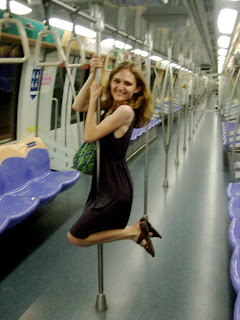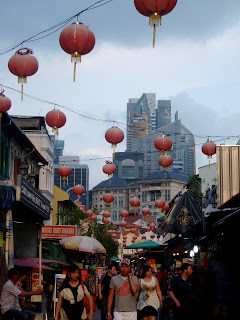On our way to Agra we passed camels, monkeys, and horse-drawn carriages. Stopping for gas, we peaked out the window to see a snake charmer with a python curled around his neck. When he saw us reaching for our cameras, he slipped the snake in a sack and flashed his fingers with his picture price in rupees.
We made quite a spectacle driving down dirt roads in an oversized charter bus with the words “Tourist Bus” splashed across the windshield, making us even more of a target than our light skin and wide eyes had already naturally made us. Vendors approached our bus waving peacock feather fans while men sipping sodas on work break grinned widely at the girls, a few even blowing kisses.
We were only a few hours from Agra in distance, but in actuality the drive took much longer. Six hours after leaving our hotel, we finally arrived a few blocks from the Taj Mahal. We took the rest of the journey on foot, pushing past peddlers selling memorabilia: Taj Mahal snow globes, decorative elephants dangling from strings, blue-beaded necklaces, and postcard books featuring twelve different views of the Taj Mahal. Many of the peddlers were small children who struck up conversations and accompanied us to the ticket gates. When one student pretended to only speak Spanish, she was surprised when the boy responded, “Hola, amiga. ¿Que tal?” Then he proceeded to start bargaining in Spanish. Maybe the best salesman ever.
We were already soaked through with sweat by the time we reached the Taj Mahal, but once we arrived complaints about heat and dehydration seemed like trivial matters. For, passing through the entrance archway, we caught our first glimpse of white marble gleaming in the sunlight. An onion-shaped dome appeared first, then the doorway, and finally the four minarets surrounding the mausoleum.
 |
| Does this photograph really need a caption? |
Now, after a six-hour long exhausting bus ride, only a long stretch of walkway and a beautiful reflecting pool separated us from the Taj Mahal. We did not properly appreciate the beautiful hedges and emerald green grass. We did not even pay attention to the pool of water which under normal conditions would have appeared refreshing and enticing. No, after a quick group picture, we headed straight forward.
We removed our shoes, adding them to the long row already at the base, and then mounted the stairs to the mausoleum. The hot marble floor scorched my feet, but I moved slowly, unable to rush past such grandeur. Inlaid marble flora: green vines with beautiful red flowers arch up the sides of the Taj Mahal, growing to the onion dome. Intricately carved Herringbone spires pierce cotton clouds. Only the dome, majestic and curvaceous, made different shades of white by the age of time, reached higher. Spacious archways lead to the Great Gate in the center. Thuluth calligraphy graces its pillars, reading “O Soul, thou art at rest. Return to the Lord at peace with Him, and He at peace with you.”
Looking over the reflecting pool, I was surrounded by the Taj Mahal before and behind me. Sunlight danced off gleaming marble and sparkled in water. We walked to each minaret, enjoying the different views each perspective afforded.
 |
| Walking inside the mausoleum. |
Inside the mausoleum presented a different kind of grandeur, one made more beautiful by the love story it tells. Before coming to the Taj Mahal, I’d imagined walking through palatial room after palatial room, admiring the grandeur of chandeliers, fine furniture, and visions of past court splendor. But the Taj Mahal was not a palace, it was a mausoleum, a place where the great Moghul emperor, Shah Jahan, lay his favorite wife and best friend, Mumtaz Mahal, to rest. Her tomb lies in the center of a small room in the mausoleum, surrounded by walls with delicate white marble flower carvings.
 |
| Standing in a room surrounding the mausoleum. |
Mumtaz Mahal (yes, the Taj Mahal derives its name from hers) died in childbirth to their fourteenth child. According to legend, after she died, Shah Jahan went into hiding for eight days, and when he returned his dark beard had turned snow-white. Later, he spent the anniversary of her death in the room, celebrating her life. Thus, the white marble walls with fine inlaid stones and elaborately carved screens speak of more than mere wealth and opulence, they manifest the story of a man’s heartbroken love.
Our visit to the Taj Mahal was continuously interrupted by people wanting to take our pictures. I posed with men, women, and children, and I was even asked to be in several family photographs. Strangely, one picture was never enough, and I got in the habit of reaching my arm out and waiting for the next family member in line to pose with me. As we’d only been allotted 45 minutes at the Taj Mahal, we eventually became concerned that we wouldn’t actually see everything if we kept taking pictures. At one point we even jested that we could cut down on photographs by taking a leaf from the book of our Spanish-speaking peddler friend and charging ten rupees per click. I would have grossed money if I’d actually put this plan into action.
We outstayed our 45 minutes, but I was still not ready to leave when we regrouped. I walked backwards out the gate to see the Taj Mahal getting smaller and smaller, until all I could see was the dome, willing my final view to last forever.
 |
| Backwards glance. |

































































